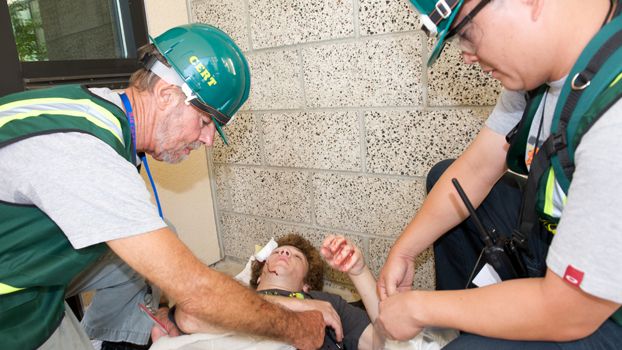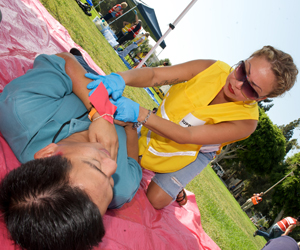 Caption:CCCCCCampus Emergency Response Team members Dennis Morris (left) and Long Lammy evaluate injuries for “victim” Michael Boyce during Cal State Fullerton’s Aug. 10 earthquake drill. Photo: Stephen Weissbart Download
Caption:CCCCCCampus Emergency Response Team members Dennis Morris (left) and Long Lammy evaluate injuries for “victim” Michael Boyce during Cal State Fullerton’s Aug. 10 earthquake drill. Photo: Stephen Weissbart Download
First Responders
Emergency Drill Puts Focus on Response
Because moments matter when rescuing those injured or trapped during a massive earthquake, campus members stepped away from their traditional Friday routines to practice their skills during an Aug. 10 earthquake drill.
Those trained in emergency response procedures, wearing green vests and hard hats, moved onto the site around Pine Hall, locating “victims,” evaluating injuries and determining whether they could remove debris that trapped some of the victims.
Victims who could walk or be transported were taken to medical responders for simulated treatment on the soccer field adjacent to Titan House.
In the University Police Building’s Emergency Operations Center, other responders gathered information on victims, evaluated damage assessments and made decisions on matters ranging from arranging for food and shelter to securing damaged buildings and, eventually, getting the campus back in order.
While the earthquake was make-believe, the actions and decisions that were being made were all too real.
“We practice so that when an earthquake or other emergency happens, we know what to do to save lives,” said Sue Fisher, campus emergency management coordinator, who planned the exercise that involved approximately 100 campus members from all segments of the institution, plus about a dozen volunteers from the community, including trained observers.
In speaking to the participants during the after-action phase of the exercise, Capt. John Brockie praised the actions of campus police officers involved in the drill. He also revealed that top command staff were considered off duty for the duration of the exercise, in order to give less-experienced officers practice in making command decisions and performing duties less familiar to them.
Trained observers from the Costa Mesa Fire Department, Community Service Programs Victims Assistance and UCI’s police department also congratulated the participants for their efforts and offered practical tips for enhancing responses during emergencies. The UCI representative also noted the involvement of the CSUF Counseling and Psychological Services team in the exercise and pointed out that her campus has not assembled such a team.
Participants offered mostly positive observations. “The drill went very well. It gave us first-hand experience in dealing with various situations and victims from those with minor to major injuries, and those who were killed. We also experienced how to respond to people with psychological problems,” said Dennis Morris, a member of the Campus Emergency Response Team.
“It was very realistic,” continued Morris, facility and security coordinator in the Pollak Library. “We learned a lot. We found areas for improvement to be better prepared for a real incident.”
Mistie Montez, a member of the Medical Emergency Response Team, agreed. The executive assistant in the Student Health and Counseling Center and co-chair of the center’s emergency preparedness committee explained how they have been practicing in-house, “and that practice really paid off. I feel that everyone responded comfortably, and it was great working with the different responder groups on campus. We made valuable connections.
“You never know when you will experience a real event,” added Montez. “This was all valuable.”
Aug. 15, 2012

